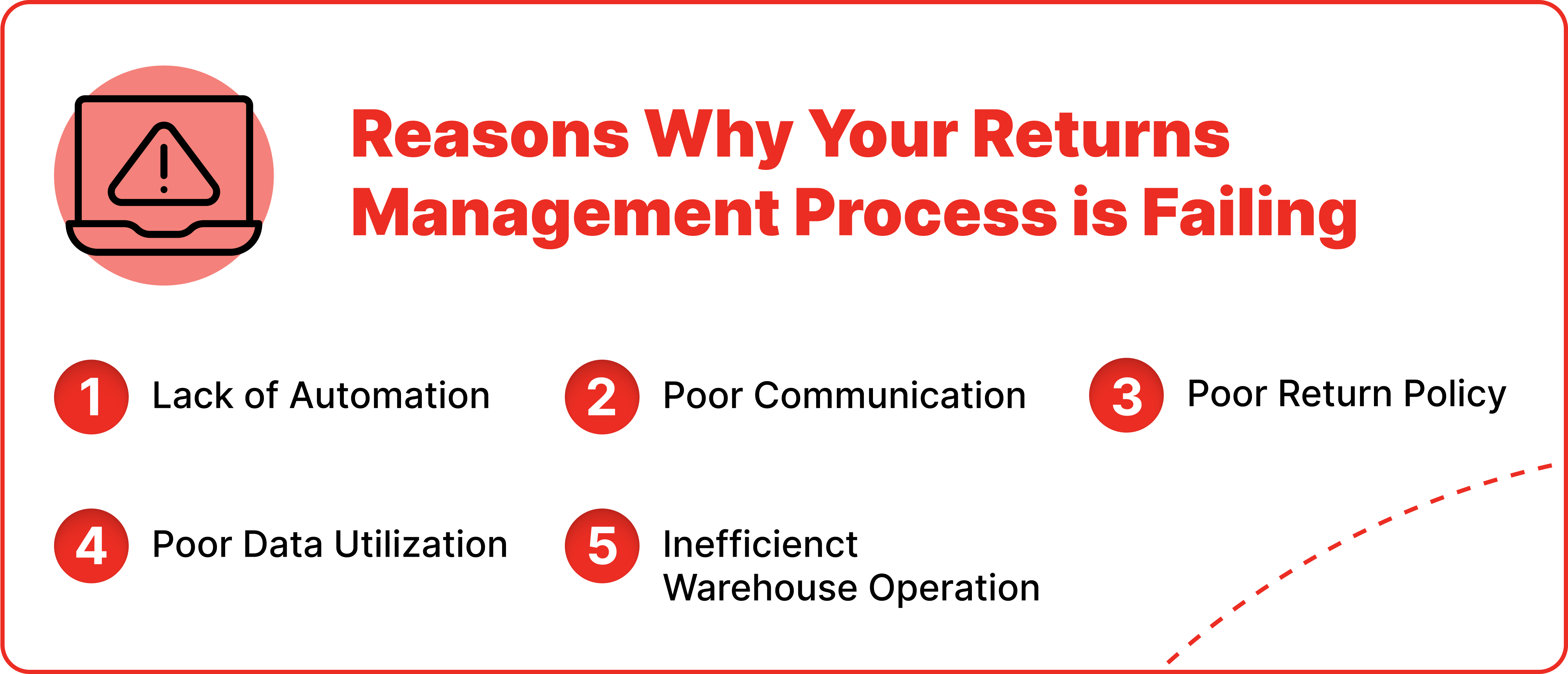5 Reasons Why Your Returns Management Process is Failing

The returns management process is the engine that powers the entire reverse logistics system for businesses and their supply chains.
Considering that 90% of customers will purchase from the business if the returns process is carried out seamlessly, retailers cannot afford to operate a failing returns management process. A seamless returns process can lead to repeat business by building customer loyalty and minimizing losses related to returns. But, the key to understanding failure is to understand why it happened. For instance, why do customers keep returning items at a significant rate? It could be because of the consistent errors from your logistics team.
Understanding why the returns management process failed will ensure that the supply chain can run an effective reverse logistics process. This article explores five major reasons why your returns management process is failing.
Consequences of Failed Returns Management Process
In 2022, the value of returned items was at $613 billion. In 2023, it rose to $743 billion, about 14.5% of the total retail sales. It is clear that the volume of returns is still on the high side, and failing to optimize it could have severe consequences for the supply chain involved. Some of these include:
1. Customer Satisfaction
Implementing slow and inefficient reverse logistics processes affects customers’ feelings about the business. If 90% of customers buy again when the returns process flows seamlessly, the same will turn their backs on them if they have a poor returns process.
2. Increased Cost of Operations
A failing returns management process will typically mean that the reverse supply chain process will be plagued with mistakes in the sorting process, poor inventory management, and wrong disposal of perfectly good products. All of these will add to the cost of logistics, potentially exposing them to possible losses.
3. Missed Opportunities
Customers are generally happy to provide feedback when processes flow smoothly. Conversely, when it is inefficient, they would be hard-pressed to provide the same. That failure to enhance the returns management process means that the business will not be able to collect valuable customer feedback on why they return the products. Without that information, the business will struggle to optimize the entire process.
Reasons Why Your Returns Management Process is Failing

In today’s modern and interconnected supply chain operations, there are five major reasons your returns management process is failing. Central to that is the application of technology. Without it, the supply chain can only do so much. The following reasons will emphasize this.
1. Lack of Automation
Manually operating the returns management process might be great for supply chains when the return volumes are low.
At a certain level, it becomes counterproductive, leading to delays, disruptions, and several bottlenecks. However, with automation, more of these supply chains can optimize the entire returns management process, leading to way more throughput across the entire returns process. Automating the returns management process begins with the customer’s initiation of the reverse logistics process. For instance, using a customer portal to initiate the process and generate a returns label without having the supply chain actively do all that. On the back end, the automated system also streamlines communication with the customers, enhancing transparency and visibility.
Although the common complaint about automation across any supply chain process is that it is too expensive, the solution more than pays for itself. The ROI means more customer satisfaction and increased customer loyalty, leading to more purchases.
The opposite will be dissatisfied customers turning their backs on the business.
2. Poor Communication (Customers and Stakeholders)
Although automation optimizes the returns management process, communication streamlines it.
The returns management process can fail because of a lack of communication with customers and other stakeholders in reverse logistics. For instance, failing to communicate effectively with customers can make them anxious and uneasy about the entire process, leading to more inquiries that can overwhelm the customer service team. To mitigate these, invest in enhancing communication with customers.
The customer portals should integrate a tracking system that shows customers where their returned goods are at every stage of the return process.
Also, ensure the customer support team is able to answer the customer’s questions when they call in. You can leverage AI bots to answer simple questions the customers might have. Communication is also relevant when managing and coordinating stakeholders in the supply chain. These stakeholders are able to work better and be in sync when there is proactive communication. They can schedule collection and delivery vehicles better, understand what location to send returned items to, and know when to kickstart processes as needed.
Communication enhances the process’s flow, leading to more throughput across the board.
3. Poor Return Policy
88% of customers will check the returns policy before placing an order, making it a significant feature for enhancing the returns management process.
Return policies document and illustrate the entire returns process for customers. They show them how to go about the return process from initiation to finish. They also show them how the returns will be processed, whether the customer will get cashback or store credit, and the rules guiding each. Beyond that, they also show the different return options available to customers.
A poor return policy is complicated, restrictive, and unclear to the consumers.
Considering that 86% of them will review the policy before purchasing, such a policy will be a turn-off for these customers. Businesses typically have a detailed returns policy, especially because they need to protect themselves from liability. However, many of these return policies are not user-friendly in terms of grammar and structure, making them more confusing for the average customer.
A user-friendly returns policy will significantly enhance the returns process for all parties.
4. Poor Data Utilization
Although customer returns are inevitable, they can be significantly reduced through the utilization of returns data.
Return data also enhances the customer experience and aids the supply chain in implementing reverse logistics processes correctly. However, doing these begins with utilizing technology solutions to collect feedback on why they are returning items. For instance, if a wrong delivery is made, the business can avoid that. If it is a case of a customer choosing the wrong item, then maybe it is time to optimize the product arrangement if it is an e-commerce business. However, failure to leverage data can lead to dissatisfaction from customers.
Doing the same thing will only increase the returns process, and customers will eventually become unhappy.
5. Inefficient Warehouse Operations
Warehouses are the operational center of the supply chain.
It is from here that supply chains can fulfill orders, but if the warehouse is inefficient, it could lead to mistakes, causing more returns and overwhelming the entire returns management operation. To change this, consider leveraging technology solutions like the Warehouse Management System to streamline and optimize the entire warehouse operations. It is important to note that inefficient warehouse operations also make integrating returned items into the inventory management systems challenging.
How ReverseLogix Streamlines and Optimizes Your Reverse Logistics
Streamlining the returns management process cannot be overemphasized. ReverseLogix helps businesses achieve repeat business by streamlining the returns management process. This is where ReverseLogix plays a critical role in your supply chain. Our Returns Management System is the solution to complex returns, but beyond that, it also gives you a competitive advantage. It comes equipped with features like automation, fraud prevention, data analysis, and environmentally friendly practices. Want to find out more? Get a Demo.
Frequently Asked Questions
There are many reasons for customer returns, especially when they are through the e-commerce platform. Sometimes, it could be the supply chain’s fault; other times, it could be the customer’s. Some common reasons for returns are receiving the wrong item, sizing issues, product dissatisfaction, or a change of mind.
The following signs are pointers to a failing or struggling returns process. And more than one of them in the returns process is a call for alarm. Look out for slow processing times, lack of communication, cumbersome return procedures, and hidden fees can all indicate a failing system.
Managing returns inefficiently can lead to frustrated customers, lost sales, increased customer service costs, and operational inefficiencies.
Manual processes will struggle to work in a fast-paced and highly competitive supply chain management landscape. You can expect the following from a returns management that leverages it: errors, time-consuming, poor packaging management, and lack of visibility in the return journey.
